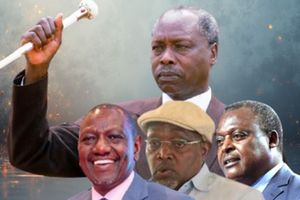Premium
Kenya-Ethiopia power line to go live this November

The 220KV Suswa substation in Narok County. The sub-station is a Vision 2030 project and is expected to handle power from the Geothermal Stations at Olkaria, Lake Turkana Wind Power and High Voltage Direct Current from Ethiopia..
Ethiopia on Tuesday conducted a successful test run of electricity supply to neighboring Kenya, the Ethiopian Electric Power utility (EEP) announced.
Mr Tewodros Ayalew-project manager said that the testing of transferring power to the Ethiopia-Kenya high voltage direct current converter station and transmission line project was successfully completed.
The trial was carried out via the 500 KV cross-border transmission power line which links the two neighbours.
According to EEP, various electro-mechanical devices and equipment installed on the project, as well as the communication data signal, were being checked and tested ahead of Tuesday's test trial.
Tewodros pointed out that it was able to connect the signal to the Kenyan network by sending a communication signal a few days ago.
Successful connection
The successful connection to power grids of the two countries will now enable Nairobi to venture into power trade business with Addis Ababa.
Last month, Kenya signed a 25-year deal with Ethiopia to start importing electricity in a bid to edge out the expensive power from the national grid and ensure buffers to meet peak demand.
Dubbed Ethiopia-Kenya Transmission Interconnection Line, the 500kV power line and converter station project was built at a cost of $334.5 million, of which $214.5 million was spent on the construction of the converter station and ground electrode line, whereas $120 million was spent on the transmission line.
Launched in 2016, the 1,045 km 'electricity highway' between Kenya and Ethiopia has the capacity to transmit up to 2,000 megawatts.
The construction work of the transmission line was completed in the spring of 2018 and the converter station in December 2021.
The project was built by China Electric Power Equipment and Technology Company (CET) while the converter station and the ground electrode line works were built by Germany-based Siemens Energy firm.
During the course of the construction, 994 line-bearing towers were installed and 440 kilometers of power transmission line and data signal transmission cables were laid.
Last year, the construction, inspection and testing of the power line on the Ethiopian side was completed, but there are reports that there are remaining construction and power installation works on the Kenyan side.
The Ethiopia Kenya transmission line – covering 433 km in Ethiopia and 612 km in Kenya – will enable Nairobi to import hydro-processed cheaper electricity from hydroelectric projects in Ethiopia.
The electricity highway, which runs from Wolayita Sodo in Ethiopia to Suswa in Narok, will be the region's first 500 kV high-voltage direct current (HVDC) line.
The project is part of the Eastern Africa Power Pool (EAPP), a regional institution established in 2005 to coordinate cross-border power trade and grid interconnection among nations of the Eastern Africa region.
Power pool
The EAPP currently has 11 member countries that signed the Inter-Governmental Memorandum of Understanding (IGMOU) and 14 utilities that signed the Inter Utility Memorandum of Understanding (IUMOU).
The pool includes the following countries: Burundi, Djibouti, Democratic Republic of Congo (DRC), Rwanda, Egypt, Ethiopia, Kenya, Sudan, Tanzania, Uganda, and Libya. South Sudan and Somalia joined recently and there is a possibility that Eritrea may join.
The EAPP's General Secretariat is based in Addis Ababa, Ethiopia with a mandate to coordinate the development and functioning/operation of the power pool.
Ethiopia, has been investing billions of dollars in building hydro-power plants in a bid to become the region's leading power exporter.
Currently the horn of Africa's nation exports electricity to Kenya, Djibouti and Sudan.





